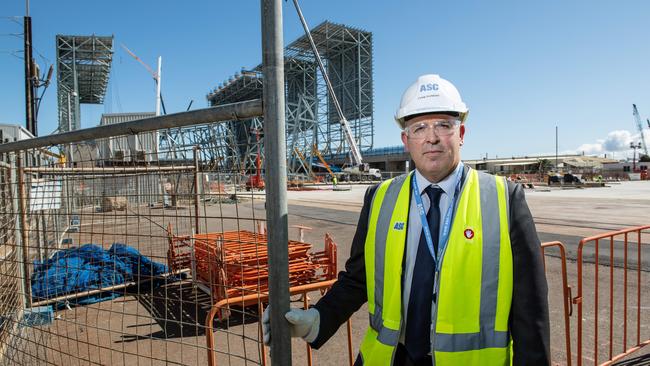Australia’s biggest ever surface ship build project was enough to lure Craig Lockhart back to Adelaide
The head of BAE’s ASC Shipbuilding subsidiary says leading a $35 billion program to build nine anti-submarine frigates for the Australian Navy is just one part of his new role - the other is to leave a lasting legacy for the country’s shipbuilding industry.
SA Business
Don't miss out on the headlines from SA Business. Followed categories will be added to My News.
- BAE to employ 100 graduates next year as frigates work ramps up
- ASC Shipbuilding hosts procurement update for frigates project
- SUBSCRIBE NOW: 50c/day for first six months - Find out more
An opportunity to spearhead the biggest surface ship build project in the country’s defence history was enough to lure Craig Lockhart back to Adelaide earlier this year.
Appointed managing director of BAE’s ASC Shipbuilding subsidiary in April, Mr Lockhart has been tasked with overseeing the $35 billion program to deliver nine anti-submarine frigates to the Australian Navy.
His newest challenge follows a 30-year career spent primarily with international defence, energy and infrastructure conglomerate Babcock, including a six-year stint in Adelaide where he became the company’s pacific region chief executive.
During that time Mr Lockhart was instrumental in the creation of a defence industry accelerator program and also contributed to the State Government’s royal commission into nuclear energy.
Hailing from Kirkcaldy, on the east coast of Scotland, Mr Lockhart returned to the UK in 2015, to head up Babcock’s naval marine division, leading a team of more than 6500 people across two naval dockyards, two naval bases, two shipyards and engineering centres.
Following his return to Australia, Mr Lockhart is committed to leaving a lasting legacy in his new home, by helping to develop a world-class sovereign shipbuilding capability.
“We’ve got two primary objectives,” he told The Advertiser during a tour of the Obsorne Shipyard.
“One is to deliver the nine (Type 26) ASW frigates, the other is to work with the Commonwealth and develop the continuous naval shipbuilding strategy, but at the same time lay down the foundations for sovereign capability.
“When it comes to the mid 2020s we want to be generating concept designs for next generation air warfare destroyers.
“It’s about making the supply chain fit to compete and clear of our expectations for (frigates) prototyping through into the first batch for building ships.
“It’s also about future proofing the supply chain for that sovereign capability challenge.”

A key part of the challenge, Mr Lockhart believes, is developing a skilled workforce capable of meeting the country’s long-term shipbuilding program.
He is working closely with Naval Group Australia chief John Davis, who’s overseeing the $50 billion submarines project, and Ian Irving from the newly established Naval Shipbuilding College, to develop a national skills framework.
The idea is to establish centres of excellence across the country to develop skills in specialist areas across the shipbuilding and maintenance cycle.
“I think we’re only just coming to terms with the size of the skilling challenge that we will require here to deliver a national shipbuilding capability,” Mr Lockhart said.
“By segmenting Australia on that basis we have a good chance of developing the capability, but it’s going to take hard yards from government, industry and academia to pull this off.
“We’ve chosen South Australia as the place that brings it all together - both for submarines and in warships.
“There will be a natural gravity to this state and that’s in supply chain, that’s in academia, that’s in research programs.
“But we would be naive to think that we have the population demographics to feed that demand - we simply don’t in the long term and I think that other states will have a big part to play.
“We have to work together - we can’t afford to be stealing from each other in order to make this work.”
ASC Shipbuilding’s Hunter-class frigates project currently employs 400 staff, with that number rising to around 2400 direct roles by 2028.
The company will take over control of the Osborne Shipyard’s southern precinct in the middle of next year, following a $535 million expansion including new steel fabrication, block assembly and ship erection halls, and other infrastructure works.
By the end of next year a two-year prototyping phase will commence, comprising a $20 million spend on development of test blocks and system trials ahead of construction of the first frigates in 2022.
Mr Lockhart said 900 supplies had already registered interest in the Hunter project, with prototyping the first opportunity for engagement.
“I think the supplier response in the main has been excellent,” he said.
“There’s 900 suppliers signed up through the process that we’ve set up to register all suppliers and make sure that they’re clear of our expectations.
“I think if there were one obvious gap, I think preparedness for that cyber security challenge we have as a defence community, is probably one of the biggest gaps that the supply chain’s not yet grasped.”
Mr Lockhart said the company was working with the State Government and Flinders University on setting up a cyber assurance test lab at Lot Fourteen, to research and test the latest technologies.
It has also rented space at the Tonsley innovation precinct to further develop plans to digitise its shipyard operations.

